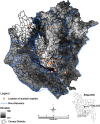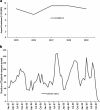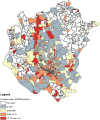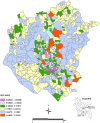Modelling typhoid risk in Dhaka metropolitan area of Bangladesh: the role of socio-economic and environmental factors
- PMID: 23497202
- PMCID: PMC3610306
- DOI: 10.1186/1476-072X-12-13
Modelling typhoid risk in Dhaka metropolitan area of Bangladesh: the role of socio-economic and environmental factors
Abstract
Background: Developing countries in South Asia, such as Bangladesh, bear a disproportionate burden of diarrhoeal diseases such as cholera, typhoid and paratyphoid. These seem to be aggravated by a number of social and environmental factors such as lack of access to safe drinking water, overcrowdedness and poor hygiene brought about by poverty. Some socioeconomic data can be obtained from census data whilst others are more difficult to elucidate. This study considers a range of both census data and spatial data from other sources, including remote sensing, as potential predictors of typhoid risk. Typhoid data are aggregated from hospital admission records for the period from 2005 to 2009. The spatial and statistical structures of the data are analysed and principal axis factoring is used to reduce the degree of co-linearity in the data. The resulting factors are combined into a quality of life index, which in turn is used in a regression model of typhoid occurrence and risk.
Results: The three principal factors used together explain 87% of the variance in the initial candidate predictors, which eminently qualifies them for use as a set of uncorrelated explanatory variables in a linear regression model. Initial regression result using ordinary least squares (OLS) were disappointing, this was explainable by analysis of the spatial autocorrelation inherent in the principal factors. The use of geographically weighted regression caused a considerable increase in the predictive power of regressions based on these factors. The best prediction, determined by analysis of the Akaike information criterion (AIC) was found when the three factors were combined into a quality of life index, using a method previously published by others, and had a coefficient of determination of 73%.
Conclusions: The typhoid occurrence/risk prediction equation was used to develop the first risk map showing areas of Dhaka metropolitan area whose inhabitants are at greater or lesser risk of typhoid infection. This, coupled with seasonal information on typhoid incidence also reported in this paper, has the potential to advise public health professionals on developing prevention strategies such as targeted vaccination.
Figures





References
-
- Kanungo S, Dutta S, Sur D. Epidemiology of typhoid and paratyphoid fever in India. J Infect Dev Count. 2008;2(6):454–460. - PubMed
-
- Nagashetty K, Channappa ST, Gaddad SM. Antimicrobial susceptibility of Salmonella Typhi in India. J Infect Dev Count. 2010;4(2):070–073. - PubMed
-
- Wang LX, Li XJ, Fang LQ, Wang DC, Cao WC, Kan B. Association between the incidence of typhoid and paratyphoid fever and meteorological variables in Guizhou, China. Chinese Med J. 2012;125(3):455–460. - PubMed
-
- Karkey A, Arjyal A, Anders KL, Boni MF, Sabina D, Koirala S, My PVT, Nga TVT, Clements ACA, Holt K, Duy PT, Day JN, Campbell JI, Dougan G, Dolecek C, Farrar J, Basnyat B, Baker S. The burden and characteristics of enteric fever at a healthcare facility in a densely populated area of Kathmandu. PloSOne. 2010;5(11):e13988. - PMC - PubMed
Publication types
MeSH terms
LinkOut - more resources
Full Text Sources
Other Literature Sources

